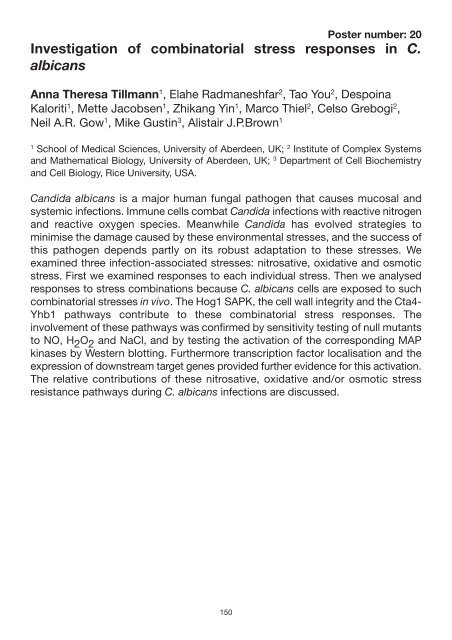Candida Infection Biology – fungal armoury, battlefields ... - FINSysB
Candida Infection Biology – fungal armoury, battlefields ... - FINSysB
Candida Infection Biology – fungal armoury, battlefields ... - FINSysB
Create successful ePaper yourself
Turn your PDF publications into a flip-book with our unique Google optimized e-Paper software.
Poster number: 20<br />
Investigation of combinatorial stress responses in C.<br />
albicans<br />
Anna Theresa Tillmann 1 , Elahe Radmaneshfar 2 , Tao You 2 , Despoina<br />
Kaloriti 1 , Mette Jacobsen 1 , Zhikang Yin 1 , Marco Thiel 2 , Celso Grebogi 2 ,<br />
Neil A.R. Gow 1 , Mike Gustin 3 , Alistair J.P.Brown 1<br />
1 School of Medical Sciences, University of Aberdeen, UK; 2 Institute of Complex Systems<br />
and Mathematical <strong>Biology</strong>, University of Aberdeen, UK; 3 Department of Cell Biochemistry<br />
and Cell <strong>Biology</strong>, Rice University, USA.<br />
<strong>Candida</strong> albicans is a major human <strong>fungal</strong> pathogen that causes mucosal and<br />
systemic infections. Immune cells combat <strong>Candida</strong> infections with reactive nitrogen<br />
and reactive oxygen species. Meanwhile <strong>Candida</strong> has evolved strategies to<br />
minimise the damage caused by these environmental stresses, and the success of<br />
this pathogen depends partly on its robust adaptation to these stresses. We<br />
examined three infection-associated stresses: nitrosative, oxidative and osmotic<br />
stress. First we examined responses to each individual stress. Then we analysed<br />
responses to stress combinations because C. albicans cells are exposed to such<br />
combinatorial stresses in vivo. The Hog1 SAPK, the cell wall integrity and the Cta4-<br />
Yhb1 pathways contribute to these combinatorial stress responses. The<br />
involvement of these pathways was confirmed by sensitivity testing of null mutants<br />
to NO, H 2 O 2 and NaCl, and by testing the activation of the corresponding MAP<br />
kinases by Western blotting. Furthermore transcription factor localisation and the<br />
expression of downstream target genes provided further evidence for this activation.<br />
The relative contributions of these nitrosative, oxidative and/or osmotic stress<br />
resistance pathways during C. albicans infections are discussed.<br />
150


